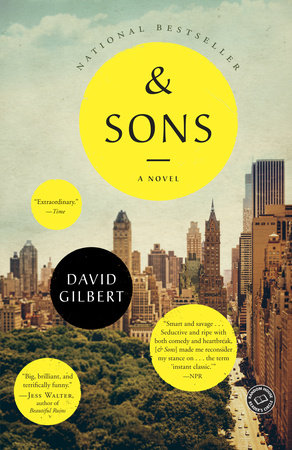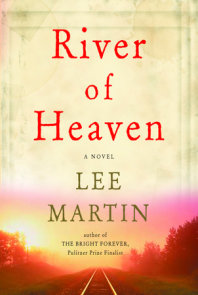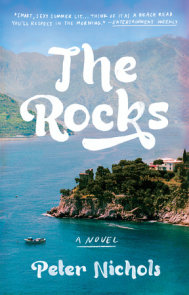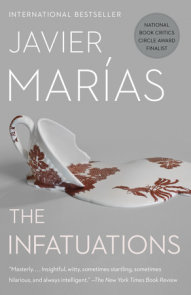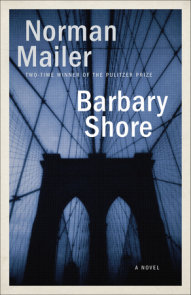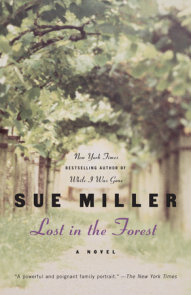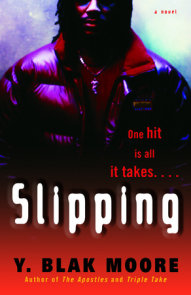READERS GUIDE
A Conversation Between David Gilbert and Curtis SittenfeldCurtis Sittenfeld is the bestselling author of four novels, Sisterland, American Wife, The Man of My Dreams, and Prep. Her books have been translated into twenty-five languages. Visit her website at www.curtissittenfeld.com.
Curtis Sittenfeld: The narrator of & Sons is a peripheral character. I love this choice, but it’s also surprising. What made you select the narrator you did rather than going with a more central character or just using a third-person omniscient point of view?
David Gilbert: I always knew I wanted to write the book in the first person but, in a tricky way, a sort of omniscient first person who by dint of his omniscience is unreliable. That’s Philip Topping. I have a soft spot for unreliable narrators, in the subtext they can generate, in the extra work the reader has to do in order to glean the “truth” of the story, in the pure fun of their uncertain claims; I also have a soft spot for outsiders peeking in through the glass, seeing a world they’re desperate to inhabit. In this book I wanted to have this question hang in the air: Who is the author of this story? Is Philip Topping truly in control? Does he have the artistic chops? If not him, then who? I wanted a certain kind of narrative shimmer, if that makes sense.
CS: Given that the focus of the novel shifts among a few characters, I’m wondering if you have a special fondness for anyone. In many books, the author’s favorite is obvious, but you’re very even-handed in making everyone flawed yet endearing.
DG: A. N. Dyer was a favorite, mainly because of his crankiness, which was enjoyable and perhaps all too natural to inhabit. Intelligence unhinged is always interesting and allows for particular flights of fancy through time. Plus it was fun to create all those unwritten novels, three hundred pages condensed into a paragraph or a line. The Andy sections were also a blast, what with the straight-ahead definition of his desire and the riff-like quality of his mind. And at the end of the day we’re both seventeen, only I’m wearing the mask of a forty-six-year-old.
CS: Although the book is primarily about fathers and sons, I admired your believable and well-rounded female characters, especially Jeanie Spokes. Do you have any favorite female characters created by either male or female novelists?
DG: I’ve always been a tremendous fan of Lily Bart and Isabel -Archer, which is appropriate since their creators had such a deep friendship. I also love Matilda, especially from reading the book to my girls. And there’s Beatrice from Much Ado About Nothing. And Emily Dickinson, who seems like a character of her own creation. And all the women in Housekeeping. And . . .
CS: The novel includes a few dramatic plot twists, especially one at the end. Did you always know what was coming or did you surprise yourself as you were writing?
DG: I had things pretty well mapped out when I started and understood the route of the plot, the ups and downs and sharp turns. But there were smaller moments that surprised me, like when Pale Male, the red-tailed hawk in Central Park, suddenly flew into the book, as did a poem about an owl, and a certain statue at 70th and Fifth Avenue, and the Von Trapp Family Singers, and how much a pretzel resembles an ampersand, which resembles a strand of DNA, and the prologue and the epilogue—those small moments of discovery can be quite novel-affirming, an unexpected detail that opens up the story and confirms you are on the right track (forgive the pun).
CS: A. N. Dyer reveals a bombshell to his adult sons, who don’t entirely believe him. Do you want readers to believe Dyer’s claim, or did you intentionally leave it open to interpretation?
DG: Hmm, how to answer this, Curtis? I certainly have my opinion, though I do want it to remain open to interpretation, but since whoever is reading this has likely read the book (and by the way, thank you, and if you are skimming the back in your local bookstore, I highly recommend The Flamethrowers and Black Swan Green and Skippy Dies and Sisterland too). I can say that I think A. N. Dyer is quite unstable at this point and he is merely weaving another tale, another piece of fiction that he hopes somehow will bring his family back together and forgive his past and ease his future. He is a professional storyteller, after all.
CS: I can’t resist asking: What’s your opinion of J. D. Salinger in general and The Catcher in the Rye specifically?
DG: The thing about J. D. Salinger—the weird thing, once you’ve read the short stories and The Catcher in the Rye—is that he sort of becomes part of you, maybe because of the age in which you access his writing, those late teen years when you yourself struggle between the poles of public and private, which often invert, so that you can feel alone among friends or totally in touch with the pulse of the world locked up in your room, and Salinger writes to this, hears our call, and also fulfills our own immature dream of mammoth success followed by the fantasy of dying while still alive, of being present at our own funeral (hello, Tom Sawyer), of feeling beloved from a self-imposed distance, without the complications of actual contact and possible compromise—Salinger is adolescence, and reading him today is like watching a home movie as directed by a master: it is artful, often wonderful, but sometimes I have to look away, sometimes the sentiment is too awkward, too trapped in a sense of self-absorbed unfairness. Did I really look that way back then? I think the lack of material has done Salinger a favor. That said, I reread The Catcher in the Rye every few years, mainly to see how I have aged.
CS: Another reason I admired this book is that the New York it evokes simultaneously feels authentic and insiderish but not off-puttingly smug. (I say this having never lived there.) I believe you grew up in New York and live there currently, and I’m curious about your relationship with the city. Have you lived elsewhere? Did you worry at all that non–New York readers might miss some of the book’s references?
DG: I have a strange relationship with New York. It is my hometown. I have lived in other places for stretches of a few years, but I always seem to find myself back in New York. I married a New Yorker. I am raising little New Yorkers. I still live on the Magic Mountain that is Manhattan, unable to escape even to Brooklyn. I am doomed. And New York has changed from the New York of my youth. (Wait a sec while I put on my Old Crank hat.) New York oozes with money now, like an infected open wound. Oh, there has always been money flowing through the bloodstream of this city, but today it feels different, today it feels stifling, apocalyptic even, the walking dead of the rich. That said, there are still the museums (though art nowadays is equated with cash), and there is the theater (which on average costs around $100 per seat), and many movie houses (mostly playing blockbusters) and great restaurants (don’t get me started). Still, there is a surviving culture here, and by that I mean the culture of the street and the subway, the park, the packed-in people, the blunt edge of close inhabitation mixed with the collective cause of being trapped and toughened and oddly dependent on one another to remain cool, i.e., New Yorkers. There remains a self-generating energy, a great grand orgy of everyday desire. I could only leave New York for Berlin or Paris or Rome, Madrid maybe, but I don’t speak those languages. I speak New York. And I hope in this novel, no matter where you’re from, you can understand the words.
CS: The title of this novel is simultaneously perfect and kind of awkward, especially to say aloud. Did you have reservations about giving your book an unwieldy title?
DG: It was always going to contain an ampersand. The title kind of dropped in fully formed. And I twisted much of the novel around that shape, in the obvious narcissistic reflection in A. N. Dyer’s name, and in his first novel, Ampersand; even in the titles of his subsequent books, there is a hint of an ampersand. Growing up I also remember seeing old ghostly advertisements on the sides of building, often with only an “& Sons” visible, the father faint and undecipherable. So I was totally committed to the title and its lack of a solid foundation.
CS: Did you use any particular strategy for writing the sections of the book that are “excerpts” of A. N. Dyer’s novels? Did you feel pressure, given that these novels are supposed to be iconic?
DG: Like I said before, that was actually fun. I could write a whole novel in a snippet without the hassle of plot and character development and pages and pages of actual painstaking writing. It was different with Ampersand since there’s a large chunk of that novel contained within the book, and it’s so beloved and acclaimed by its readership (it won a Pulitzer, after all). I just kind of held my breath (and at times my nose) and dove in. I had the whole internal novel pretty well mapped out, to the point where it seems like I’ve written it. But it does set up as an easy target: This is meant to be great? Yeah, right. But I understood that going into the project, that there was that danger, and to be honest, it was thrilling to take on the challenge.
CS: This is your third book. What do you know now about writing and publishing that you didn’t know before your first?
DG: Unfortunately, not a lot. The first blank page is always a mystery. Maybe when I first started writing I disparaged plot, thinking it a hack’s course, but nowadays, we novelists have to compete with so many other easier (and frankly wonderful) entertainments, we need to remember the basics of story and plot and forward momentum and character and, most important, the pleasures to be found on that once blank page. We need to prove ourselves worthy of the most precious commodity: time.
Questions and Topics for Discussion
1. First of all, thank you for reading the book. Want to get that out of the way. A big thanks. One of the scariest things a person can tell me is “Oh, hey, I’m reading your book.” It makes me want to crawl directly into the nearest hole. Funny choice of career. Here I’ve published a book with a big-time publisher—dream come true—and the knowledge that someone might actually read my book makes me cringe to the point of splitting in two. I’m cringing now. The other scary thing you can tell me is “Oh, hey, I read your book,” particularly if you tweak the verb with a raised eyebrow, like a hairy umlaut. I might smile in return and say, Oh Great, that’s great, but in reality I’m performing a private Seppuku ceremony, a thousand doubts the blade. Anyway, discuss vis-à-vis A. N. Dyer and ask yourself, “Why would anyone want to be a writer?”
2. It took me six years to write this book, which seems a ridiculous amount of time. I mean, it’s a kind of a long book, but six years long? At best three years, maybe three and a half while also maintaining a full-time gig with Doctors Without Borders. Now A. N. Dyer hasn’t written a truly new book in something like twenty years (forgive the vagueness, but it’s been a year since I actually read this book). Why do you think he’s stopped writing? I have my ideas, obviously. I think it has something to do with the breakup of his marriage—duh—but also with the birth of his third son, the young Andy. Has this boy perhaps taken on the role of fiction? What is Andy’s relationship with fiction in terms of his relationship with his father? Did I just answer my own question? I don’t think I’m very good at this.
3. You know when you go to the theater and you read the Playbill and there are those bios for the actors and the director and the playwright (I love reading those bios)? Did you know that those bios are actually written by the actors and the director and the playwright? You probably did, but for some reason I didn’t, or not until maybe ten years ago. I just assumed there was a national bio database, very official, probably housed in a suburb of D.C., that fact-checked and sourced and confirmed all this professional information. Yes, yes, Patty St. John did indeed play Fastrada in the Tacoma Players’ 2007 production of Pippin. It wasn’t until I started seeing those personalized messages that suddenly became popular—“Ms. St. John would like to express her gratitude to her Chihuahua Chekhov for teaching her how to be human”—that I realized, Wait a sec, these things are actually self-constructed. At first I was shocked. It seemed dubious. And kind of braggy too. How much of this is truly true? But then I found myself digging into these credits, not only to suss out a career but also to suss out a person, and suddenly a deeper appreciation began to emerge from those handmade bios. A trajectory. I mean, how do we compose our lives for public consumption? What do we say? And where are the divergences, the betraying tells? Who is composing who? Or is it whom? And does David Gilbert live in New York City or does he live in Brooklyn or in Queens? Is that a question?
4. I don’t normally like books about writers. A writer writing about a writer writing, well, that sentence alone is tedious. I want to read about someone who does something. Like I wish someone would write the great American novel about scuba diving. That would be cool. Shipwrecks. Sharks. Those giant clams and your foot is suddenly caught. There has to be treasure too. We as a nation deserve a fabulous piece of scuba diving literature. But another book about a writer? And an old privileged white male writer at that? I almost feel as if I should apologize. That said, what interested me was the tension between fiction and life and how we twist our own stories to suit our will. I remember in fifth-grade English class the teacher mentioning in Huck Finn the theme of Appearance Versus Reality, underlined twice on the chalkboard, and I was blown away by the notion—yes, yes, appearance versus reality! It was my Matrix moment. My teenage anthem. Like Jake with Chinatown, it explained all things without explaining a thing. It is, after all, the mother of all themes and introduces by far the most interesting element of any decent piece of writing, the subtext. So: What is the subtext of & Sons? Sorry, that’s a terrible question.
5. Okay, how about this: Who is telling the story? And how is he telling the story? Is this an act of autobiography or an act of fiction, and is there a difference between the two? I mean, we have the one narrator and then we have each chapter divided into three separate character-driven parts (and here I have to acknowledge Richard Powers since I essentially stole that structure from him—a really useful structure by the way, if you’re ever looking for structure—and Philip Roth’s Zuckerman books in the way Zuckerman jumps into other people’s heads yet always remains distinctly individual). I guess the question is: How good a writer is Philip Topping? Also, a follow-up: What writer is the biographer of your life? (For me, it’s Charles Schulz.)
6. Why all the Wizard of Oz allusions? Seriously. I think a lot of readers assume that the writer has relative control of his/her text, but I can tell you that that simply is not true. I mean, that’s not true either, and no need to bring up Derrida or any of the deconstructionists, please God no, though during the eighties I used to say Paul-De-Man instead of You’re Da Man (and got just as many laughs), but in all seriousness, I wrote a draft of this book and looked over it and saw all of these Wizard of Oz references, which I then burnished since it seemed so odd and unexpected and must mean something. So tell me about Dorothy. And Kansas and Oz. Who is the Wicked Witch?
7. Is this tedious?
8. Why did I write this book? Finally, a question for me. I wrote this book because I have a son and a father and I myself am a son and a father and this funhouse mirror effect has been interesting, to say the least. Raising children is an act of love as well as an act of fiction in which the characters slowly free themselves from the supposed author. I remember being scared about having a boy. There seemed so much pressure involved. How would I teach someone how to be a man when I had no idea how to be a man myself? My own father is a wonderful guy, very impressive, an intimidating figure to me when I was growing up, as well as bit distant. He himself was the product of a strict family, raised by a stepfather after his own father’s early death. Anyway, my dad had a successful career in banking, and I remember when I was in my early thirties and just starting my own family, I was at an event and my father had to get up and say a few words and he was as always confident and charming, a commanding presence, and this old friend of his was sitting next to me and she leaned over and said, “It really is amazing, seeing your dad in these situations, so comfortable and at ease, considering how painfully shy he was as a boy. I mean, he could barely look you in the eye and had a bit of stammer. Amazing, the transformation.” Now this surprised me. I’ve always known him as a reserved and self-contained man, a bit unknowable, but never as a shy and awkward boy, and so I remember imagining: What if I could meet him when he was younger, say seventeen? How would my impressions change? That was the impetus behind & Sons. Hence this follow-up question: What if you could meet your father when he was five, or ten, or fifteen, at the height of his vulnerability? How would your feelings for the man change? We all reinvent ourselves with our children.
9. Let’s talk about the book within the book, Ampersand. Go ahead, I’m listening.
10. Okay, the women in the book—I know, what women? But hey, the book’s called & Sons, what did you expect? That said, there are women, in particular Isabel Dyer and Eleanor Topping, and they do play their part. How do these women function within this world of boys (notice I didn’t use the word men)? Does it ring true? I really wanted to make Richard’s wife, Candy, a bigger character and there was a scene in an early outline where she bonded with A. N. Dyer (much to the frustration of Richard), but I couldn’t quite find the narrative space for its inclusion. I’m curious, did I get away with my impersonation of Alice Munro in that Isabel chapter? I’m a fan of her stories and I loved trying to write in her particular style, not just overtly but covertly (and setting some action on a train). That said, is there a deeper purpose to my impersonation? What does it say about the fluid nature of authorship?
11. The novel has a prologue and an epilogue, though thankfully not tagged as prologue and epilogue since I myself always skip prologues and epilogues. I’ve never understood their purpose. Just start the book and end the book. I’ve never read a prologue and said, “Wow, now that’s a great prologue.” And an epilogue is like that awkward encounter with a friend after you say goodbye and depart down the street in the same direction. “Oh, yeah, hey [awkward laugh].” That said, I am guilty of writing a prologue and epilogue (italicized, no less). For me to stoop to this shame, there must be a reason . . . I hope.
12. Does Phillip Topping work as a narrator? I mean, yeah, he’s kind of unreliable, (unreliable narrator is like Subtext 101), but do you believe him? I know, I know, I just said he’s unreliable, but how much of what he says is believable? The same with A. N. Dyer. I know, I know, A. N. Dyer is being filtered through Phillip, his biggest fan, who at the same time is trying to channel A. N. Dyer—so many layers of fiction. I guess the question is: Who is the dog and who is the tail?
13. Do you like the letters? Regardless, they look great. The Random House interior designers did an incredible job to create that sense of reality. That was very important to me, to maintain a tight grip on the real, just like all the locations in New York and beyond are very real places, the same with the schools. That reality was key. Why do you think I cared so much? Sometimes I think of A. N. Dyer as a spider who has spun his web in the corner of these realities, a beautiful and intricate construction, lovely to behold, and not once does he think of the poor creatures who blindly fly into these traps and find themselves stuck and immobilized, a sudden character in one of his dramas. What stories do you tell yourself about your own life that you know are untrue, those exaggerations that have become fact? How much of who we are is what we steal? And if fiction can bring a family together, do we care about the truth?
14. If you called someone up and told them to come find you in front of your favorite work of art, where would you be standing?
15. With Richard in the beginning, when he’s at the movie studio and feels as if his dreams are about to come true, Richard playing the fantasy forward and then discovering, too late for his ego, that he has misread the situation, can you relate to this mortifying situation? I certainly can. I once thought a girl was madly in love with me but actually she was in love with my best friend—wait, is that me or a movie I saw? How much of our memory is collage?
16. Dream Snap is an anagram of Ampersand. Do those kinds of games interest you? If they do, play on.
17. When I started & Sons I wrote a single word on a Post-it note and stuck it to the wall in front of my desk. What was that word? Five dollars to anyone who guesses right.







